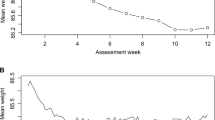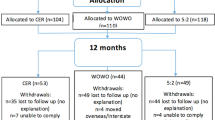Abstract
Background
Weight-loss programmes often achieve short-term success though subsequent weight regain is common. The ability to identify predictive factors of regain early in the weight maintenance phase is crucial.
Objective
To investigate the associations between short-term weight variability and long-term weight outcomes in individuals engaged in a weight-loss maintenance intervention.
Methods
The study was a secondary analysis from The NoHoW trial, an 18-month weight maintenance intervention in individuals who recently lost ≥5% body weight. Eligible participants (n = 715, 64% women, BMI = 29.2 (SD 5.0) kg/m2, age = 45.8 (SD 11.5) years) provided body-weight data by smart scale (Fitbit Aria 2) over 18 months. Variability in body weight was calculated by linear and non-linear methods over the first 6, 9 and 12 weeks. These estimates were used to predict percentage weight change at 6, 12, and 18 months using both crude and adjusted multiple linear regression models.
Results
Greater non-linear weight variability over the first 6, 9 and 12 weeks was associated with increased subsequent weight in all comparisons; as was greater linear weight variability measured over 12 weeks (up to AdjR2 = 4.7%). Following adjustment, 6-week weight variability did not predict weight change in any model, though greater 9-week weight variability by non-linear methods was associated with increased body-weight change at 12 (∆AdjR2 = 1.2%) and 18 months (∆AdjR2 = 1.3%) and by linear methods at 18 months (∆AdjR2 = 1.1%). Greater non-linear weight variability measured over 12 weeks was associated with increased weight at 12 (∆AdjR2 = 1.4%) and 18 (∆AdjR2 = 2.2%) months; and 12-week linear variability was associated with increased weight at 12 (∆AdjR2 = 2.1%) and 18 (∆AdjR2 = 3.6%) months.
Conclusion
Body-weight variability over the first 9 and 12 weeks of a weight-loss maintenance intervention weakly predicted increased weight at 12 and 18 months. These results suggest a potentially important role in continuously measuring body weight and estimating weight variability.
This is a preview of subscription content, access via your institution
Access options
Subscribe to this journal
Receive 12 print issues and online access
$259.00 per year
only $21.58 per issue
Buy this article
- Purchase on Springer Link
- Instant access to full article PDF
Prices may be subject to local taxes which are calculated during checkout




Similar content being viewed by others
Data availability
There are legal restrictions on sharing data that contain potentially identifying or sensitive person information. The restrictions are imposed by The Danish Data Protection Agency (https://www.datatilsynet.dk/english/). Data used in the current study will be made available upon request after application to the NoHoW data controller (The James Hutton Institute: https://www.hutton.ac.uk/). The application procedure can be obtained from The James Hutton Institute (DPO@hutton.ac.uk) or David Nutter (david.nutter@bioss.ac.uk).
References
Van Wye G, Dubin JA, Blair SN, DiPietro L. Adult obesity does not predict 6-year weight gain in men: the aerobics center longitudinal study. Obesity. 2007;15:1571–7.
Speakman JR, Westerterp KR. Associations between energy demands, physical activity, and body composition in adult humans between 18 and 96 y of age. Am J Clin Nutr. 2010;92:826–34.
Turicchi J, O’Driscoll R, Horgan G, Duarte C, Palmeira AL, Larsen SC, et al. Weekly, seasonal and holiday body weight fluctuation patterns among individuals engaged in a European multi-centre behavioural weight loss maintenance intervention. PLoS One. 2020;15:e0232152.
Bhutani S, Kahn E, Tasali E, Schoeller DA. Composition of two-week change in body weight under unrestricted free-living conditions. Physiol Rep. 2017;5. https://doi.org/10.14814/phy2.13336.
Lowe MR, Feig EH, Winter SR, Stice E. Short-term variability in body weight predicts long-term weight gain. Am J Clin Nutr. 2015;102:995–9.
Lowe MR, Benson L, Singh S. Individual differences in within-subject weight variability: there’s a signal in the noise. Physiol Behav. 2020;226:113112.
Stice E, Durant S, Burger KS, Schoeller DA. Weight suppression and risk of future increases in body mass: effects of suppressed resting metabolic rate and energy expenditure 1-3. Orig Res Commun Am J Clin Nutr. 2011;94:7–11.
Pietiläinen KH, Saarni SE, Kaprio J, Rissanen A. Does dieting make you fat? A twin study. Int J Obes. 2012;36:456–64.
Higginson AD, McNamara JM. An adaptive response to uncertainty can lead to weight gain during dieting attempts. Evol Med Public Heal. 2016;2016:369–80.
Strychar I, Lavoie M-È, Messier L, Karelis AD, Doucet É, Prud’homme D, et al. Anthropometric, metabolic, psychosocial, and dietary characteristics of overweight/obese postmenopausal women with a history of weight cycling: a MONET (Montreal Ottawa New Emerging Team) Study. J Am Diet Assoc. 2009;109:718–24.
Kajioka T, Tsuzuku S, Shimokata H, Sato Y. Effects of intentional weight cycling on non-obese young women. Metabolism. 2002;51:149–54.
Jebb SA, Goldberg GR, Coward WA, Murgatroyd PR, Prentice AM. Effects of weight cycling caused by intermittent dieting on metabolic rate and body composition in obese women. Int J Obes. 1991;15:367–74.
Fothergill E, Guo J, Howard L, Kerns JC, Knuth ND, Brychta R, et al. Persistent metabolic adaptation 6 years after “The Biggest Loser” competition. Obesity. 2016;24:1612–9.
Zhou Y, Gao X, Chen H, Kong F. High-disinhibition restrained eaters are disinhibited by self-regulatory depletion in the food-related inhibitory control. Eat Behav. 2017;26:70–5.
Lowe MR. Dieting: proxy or cause of future weight gain? Obes Rev. 2015;16:19–24.
Stergiou N, Decker LM. Human movement variability, nonlinear dynamics, and pathology: is there a connection? Hum Mov Sci. 2011;30:869–88.
Kodama S, Fujihara K, Ishiguro H, Horikawa C, Ohara N, Yachi Y, et al. Unstable bodyweight and incident type 2 diabetes mellitus: a meta-analysis. J Diabetes Investig. 2017;8:501–9.
Zou H, Yin P, Liu L, Liu W, Zhang Z, Yang Y, et al. Body-weight fluctuation was associated with increased risk for cardiovascular disease, all-cause and cardiovascular mortality: a systematic review and meta-analysis. Front Endocrinol. 2019;10:728.
Turicchi J, O’Driscoll R, Horgan G, Duarte C, Santos I, Encantado J, et al. Body weight variability is not associated with changes in risk factors forcardiometabolic disease. Int J Cardiol Hypertens. 2020;6:100045.
Feig EH, Lowe MR. Variability in weight change early in behavioral weight loss treatment: theoretical and clinical implications. Obesity. 2017;25:1509–15.
Benson L, Zhang F, Espel-Huynh H, Lua W, Lowe MR. Weight variability during self-monitored weight loss predicts future weight loss outcome. Int J Obes. 2020. https://doi.org/10.1038/s41366-020-0534-6.
Scott SE, Duarte C, Encantado J, Evans EH, Harjumaa M, Heitmann BL, et al. The NoHoW protocol: a multicentre 2×2 factorial randomised controlled trial investigating an evidence-based digital toolkit for weight loss maintenance in European adults. BMJ Open. 2019;9:e029425.
Folsom AR, French SA, Zheng W, Baxter JE, Jeffery RW. Weight variability and mortality: the Iowa Women’s Health Study. Int J Obes Relat Metab Disord. 1996;20:704–9.
Turicchi J, O’Driscoll R, Finlayson G, Duarte C, Palmeira AL, Larsen SC, et al. Data imputation and body weight variability calculation using linear and nonlinear methods in data collected from digital smart scales: simulation and validation study. JMIR Mhealth Uhealth. 2020;8:e17977.
Saito Y, Takahashi O, Arioka H, Kobayashi D. Associations between body fat variability and later onset of cardiovascular disease risk factors. PLoS ONE. 2017;12:e0175057.
Lee J, Kawakubo K, Kobayashi Y, Mori K, Kasihara H, Tamura M. PAPER Effects of ten year body weight variability on cardiovascular risk factors in Japanese middle-aged men and women. Int J Obes. 2001;25:1063–7.
French S, Folsom A, Jeffery R, Zheng W, Mink P, Baxter J. Weight variability and incident disease in older women: the Iowa Women’s Health Study. https://www.nature.com/articles/0800390.pdf?origin=publication_detail. Accessed 22 Dec 2017.
Taylor CB, Jatulis DE, Fortmann SP, Kraemer HC. Weight variability effects: a prospective analysis from the stanford five-city project. Am J Epidemiol. 1995;141:461–5.
Kim MK, Han K, Park Y-M, Kwon H-S, Kang G, Yoon K-H, et al. Associations of variability in blood pressure, glucose and cholesterol concentrations, and body mass index with mortality and cardiovascular outcomes in the general population. Circulation. 2018;138:2627–37.
Johnson F, Pratt M, Wardle J. Dietary restraint and self-regulation in eating behavior. Int J Obes. 2012;36:665–74.
Westenhoefer J. Dietary restraint and disinhibition: is restraint a homogeneous construct? Appetite. 1991;16:45–55.
Bryant EJ, Kiezebrink K, King NA, Blundell JE. Interaction between disinhibition and restraint: implications for body weight and eating disturbance. Eat Weight Disord. 15:e43–51.
Winter SR, Yokum S, Stice E, Osipowicz K, Lowe MR. Elevated reward response to receipt of palatable food predicts future weight variability in healthy-weight adolescents. Am J Clin Nutr. 2017;105:781–9.
Turicchi J. jaketuricchi/Publication_scripts: scripts associations with published studies. https://github.com/jaketuricchi/Publication_scripts. Accessed 24 Aug 2020.
Althouse AD. Adjust for multiple comparisons? It’s not that simple. Ann Thorac Surg. 2016;101:1644–5.
Rubin M, Do P. Values lose their meaning in exploratory analyses? It depends how you define the familywise error rate. Rev Gen Psychol. 2017;21:269–75.
Turicchi J, O’Driscoll R, Finlayson G, Beaulieu K, Deighton K, Stubbs RJ. Associations between the rate, amount, and composition of weight loss as predictors of spontaneous weight regain in adults achieving clinically significant weight loss: a systematic review and meta‐regression. Obes Rev. 2019. https://doi.org/10.1111/obr.12849.
Turicchi J, O’Driscoll R, Finlayson G, Duarte C, Hopkins M, Martins N, et al. Associations between the proportion of fat-free mass loss during weight loss, changes in appetite, and subsequent weight change: results from a randomized 2-stage dietary intervention trial. Am J Clin Nutr. 2020;111:536–44.
Zheng Y, Klem MLou, Sereika SM, Danford CA, Ewing LJ, Burke LE. Self-weighing in weight management: a systematic literature review. Obesity. 2015;23:256–65.
Shieh C, Knisely MR, Clark D, Carpenter JS. Self-weighing in weight management interventions: a systematic review of literature. Obes Res Clin Pract. 2016;10:493–519.
Kroke A, Liese A, Schulz M, Bergmann M, Klipstein-Grobusch K, Hoffmann K, et al. Recent weight changes and weight cycling as predictors of subsequent two year weight change in a middle-aged cohort. Int J Obes. 2002;26:403–9.
Field AE, Manson JE, Taylor CB, Willett WC, Colditz GA. Association of weight change, weight control practices, and weight cycling among women in the Nurses’ Health Study II. Int J Obes. 2004;28:1134–42.
Orsama A-L, Mattila E, Ermes M, van Gils M, Wansink B, Korhonen I. Weight rhythms: weight increases during weekends and decreases during weekdays. Obes Facts. 2014;7:36–47.
Rosenbaum DL, Schumacher LM, Schaumberg K, Piers AD, Gaspar ME, Lowe MR, et al. Energy intake highs and lows: how much does consistency matter in weight control? Clin Obes. 2016;6:193–201.
Thomas DM, Martin CK, Redman LM, Heymsfield SB, Lettieri S, Levine JA, et al. Effect of dietary adherence on the body weight plateau: a mathematical model incorporating intermittent compliance with energy intake prescription. Am J Clin Nutr. 2014;100:787–95.
Acknowledgements
The author’s responsibilities were as follows—BLH and JS acquired funding and designed the NoHoW trial; JT designed and leds the present secondary study; JT and ML were involved in conceptualisation and hypothesis generating; JT and ROD implemented all statistical analyses; JT wrote the manuscript; JT, JS, GF, ROD, ML, ALP, SCL, and BLH were involved in editing the manuscript; all authors approved the final manuscript; JT had primary responsibility for the final content. We thank all individuals involved in the collection of data and trial maintenance at The University of Leeds (UK), The University of Lisbon (PT) and The Parker Institute (DK).
Funding
The NoHoW study received funding from the European Union’s Horizon 2020 research and innovation programme (Grant Agreement Number: 643309). Funding for the present analysis was part of a PhD studentship from the University of Leeds awarded to JT.
Author information
Authors and Affiliations
Corresponding author
Ethics declarations
Conflict of interest
The authors declare that they have no conflict of interest.
Additional information
Publisher’s note Springer Nature remains neutral with regard to jurisdictional claims in published maps and institutional affiliations.
Supplementary information
Rights and permissions
About this article
Cite this article
Turicchi, J., O’Driscoll, R., Lowe, M. et al. The impact of early body-weight variability on long-term weight maintenance: exploratory results from the NoHoW weight-loss maintenance intervention. Int J Obes 45, 525–534 (2021). https://doi.org/10.1038/s41366-020-00706-0
Received:
Revised:
Accepted:
Published:
Issue Date:
DOI: https://doi.org/10.1038/s41366-020-00706-0



